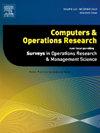带容量船舶转运系统的同步干船坞调度
IF 4.1
2区 工程技术
Q2 COMPUTER SCIENCE, INTERDISCIPLINARY APPLICATIONS
引用次数: 0
摘要
尽管船队老化和全球船队规模的增长推动了维护需求的快速增长,但优化干船坞运营仍然是学术研究的一个未充分探索的领域。本研究旨在通过改进干船坞调度来提高效率,以缓解维修需求与有限的干船坞资源之间日益增长的差距。我们提出了一个包含有能力船舶转运系统的实际同步船坞调度问题,该问题要求确定船舶维修服务的最佳顺序以最小化总等待时间。混合整数线性规划(MILP)模型通过将船舶转运系统建模为一系列具有不同容量和转运限制的区段,有效地解决了这一问题的挑战,特别是船舶转运系统——一个涉及同步升降机和铁路的关键瓶颈。该模型适应调度过程的复杂性,如有限的传输容量、不同的区段特征、双向船舶传输流、船舶兼容性约束和顺序相关的设置时间。认识到问题的NP-hard性质,我们引入了一种新的基于列生成的启发式方法来有效地求解MILP模型。利用NOSCO造船厂的实际操作数据进行了大量的数值实验,验证了所提出的求解方法的有效性。结果表明,与先到先服务的调度方案相比,船舶等待时间减少了32.5%,显著提高了运营效率。本文章由计算机程序翻译,如有差异,请以英文原文为准。
Syncrolift dry dock scheduling with a capacitated ship transfer system
Despite the rapidly increasing maintenance demand driven by an aging fleet and the growth of global fleet size, optimizing dry dock operations remains an underexplored area in academic research. This study addresses this gap by focusing on enhancing efficiency through improved dry dock scheduling, aiming to alleviate the growing disparity between maintenance needs and limited dry dock resources. We propose a practical syncrolift dry dock scheduling problem that incorporates a capacitated ship transfer system, which requires determining the optimal sequence of ship maintenance services to minimize total waiting time. A mixed-integer linear programming (MILP) model is developed to effectively tackle the challenges of this problem, particularly the ship transfer system—a critical bottleneck involving the syncrolift and railways—by modeling it as a series of segments with varying capacities and transfer restrictions. The model accommodates the complexities of the scheduling process, such as limited transfer capacity, diverse segment characteristics, bidirectional ship transfer flows, ship compatibility constraints, and sequence-dependent setup times. Recognizing the NP-hard nature of the problem, we introduce a novel column-generation-based heuristic method to solve the MILP model efficiently. The efficacy of the proposed solution method is validated through extensive numerical experiments using real operational data from the NOSCO shipyard. Results demonstrate significant improvements in operational efficiency, with ship waiting times reduced by 32.5% compared to first-come-first-served scheduling solutions.
求助全文
通过发布文献求助,成功后即可免费获取论文全文。
去求助
来源期刊

Computers & Operations Research
工程技术-工程:工业
CiteScore
8.60
自引率
8.70%
发文量
292
审稿时长
8.5 months
期刊介绍:
Operations research and computers meet in a large number of scientific fields, many of which are of vital current concern to our troubled society. These include, among others, ecology, transportation, safety, reliability, urban planning, economics, inventory control, investment strategy and logistics (including reverse logistics). Computers & Operations Research provides an international forum for the application of computers and operations research techniques to problems in these and related fields.
 求助内容:
求助内容: 应助结果提醒方式:
应助结果提醒方式:


